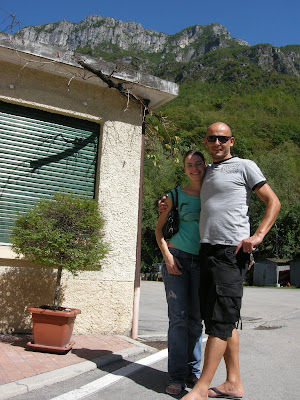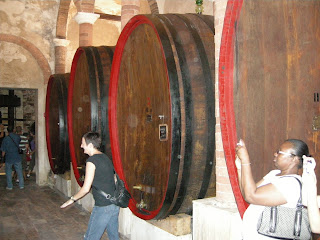


I live above a trattoria in Italy.
The time in ALMA school is over now, and all of us from George Brown Chef School in Toronto, and ALMA in Italy, are out on stage, at trattorias, restaurants, hotels and fine spas all over Italy. Some students have gone to small places in Sicily, some to large cities. One is in Venice, one in Bologna. Students are in Savona, Piacenza, Cortona, Cuneo, Rome, Parma; all over the place. ALMA has placed us with the finest cooks and chefs in Italy.
A trattoria is not a large restaurant ... it is more of a small, intimate operation, run by two or three people, completely dedicated to the typical produce of the area. For me, the ‘trattoria’ implies a work-in-progress, a personal investigation on the part of the Chef.
In Italy the idea of ‘typical’ is everywhere in the food world ... I see advertisements for typical food on little bars, trattorias, almost everywhere. It is a concept that most people here take enormous pride in, and have deep concern for. Typical implies respect for the land (so it can keep producing), for the methods used, for the presentation, cooking methods, wines available, even the manner of presentation (see the previous blog about Mr. Marchesi for deeper detail on this.) Manner and style are very important here ... nothing is just cranked out and banged down in front of customers who happen to lurch through the doors ... the choice of where to dine, when and with whom is carefully and deliberately made. (Canadians who have not travelled much have SO much to learn from this concept!)
I have the good fortune to work with Chef Cristian Zana at his trattoria, “Trattoria All’Isola” in Cogollo, near Vicenza, about 100 km to the west of Venice. Chef has had the trattoria open for about 7 years. He runs the kitchen and his delightful partner, Sylvia, runs the front-of-house operation. Sylvia is a sommelier, highly-trained and knowledgeable. Sylvia and Chef have welcomed me with open arms into their life of work and play. They are bright, very talented and enthusiastic. And they set one furious pace! Everything here is hand-made. We get along well in a mix of their excellent Italian and our self-generated mash-up of English and Italian. Their concern for my learning is strongly evident. They are unfailingly kind and generous.
A few examples will suffice, I think, to demonstrate the furious pace. I arrived on Friday at about 4 in the afternoon, and after taking a fast nap of 25 minutes , and taking time to change into whites, I went to work in the kitchen starting at about 5 until 1 in the morning. We served 2 people that night ... customers linger ...
Chef had me watch some operations and executions for the first 20 minutes, firing off fairly rapid Italian mixed with some English. Then I had to start producing ... and managed to. Last night (my second in the trattoria) we served 17 customers (a large number for this small place and tiny kitchen) ... our work evening started at about 5 PM and we walked out of the restaurant together at 1:45 AM to go for pizza! I rolled into bed just before 3.
Chef had me making parts of dishes ... steak tartare, prep of many vegetables, making bread, making pasta, making a kind of vegetable tortellini, plating dishes, making octopus salad, peeling spuds, carrots and running for him to the refrigerator (up a flight of ancient stairs), to the freezers, to the patisserie area, helping with making sauces, preparing rabbit ragout, preparing duck legs, running a vacuum-seal machine, forming pasta frolla into tiny baking dishes, and making it all a joy! His Mum comes in at night and runs the dishwasher and cleans, and Sylvia looks after making sure everything goes through the door on time, in order. What an operation.
And what a joy to be part of ... work hard and play hard. As Andrew, one of the other George Brown students said when we were all together at ALMA, “Face it ... We’re a bunch of adrenaline junkies getting our fix playing with sharp objects and peoples’ digestive systems.” He was right.
The time in ALMA school is over now, and all of us from George Brown Chef School in Toronto, and ALMA in Italy, are out on stage, at trattorias, restaurants, hotels and fine spas all over Italy. Some students have gone to small places in Sicily, some to large cities. One is in Venice, one in Bologna. Students are in Savona, Piacenza, Cortona, Cuneo, Rome, Parma; all over the place. ALMA has placed us with the finest cooks and chefs in Italy.
A trattoria is not a large restaurant ... it is more of a small, intimate operation, run by two or three people, completely dedicated to the typical produce of the area. For me, the ‘trattoria’ implies a work-in-progress, a personal investigation on the part of the Chef.
In Italy the idea of ‘typical’ is everywhere in the food world ... I see advertisements for typical food on little bars, trattorias, almost everywhere. It is a concept that most people here take enormous pride in, and have deep concern for. Typical implies respect for the land (so it can keep producing), for the methods used, for the presentation, cooking methods, wines available, even the manner of presentation (see the previous blog about Mr. Marchesi for deeper detail on this.) Manner and style are very important here ... nothing is just cranked out and banged down in front of customers who happen to lurch through the doors ... the choice of where to dine, when and with whom is carefully and deliberately made. (Canadians who have not travelled much have SO much to learn from this concept!)
I have the good fortune to work with Chef Cristian Zana at his trattoria, “Trattoria All’Isola” in Cogollo, near Vicenza, about 100 km to the west of Venice. Chef has had the trattoria open for about 7 years. He runs the kitchen and his delightful partner, Sylvia, runs the front-of-house operation. Sylvia is a sommelier, highly-trained and knowledgeable. Sylvia and Chef have welcomed me with open arms into their life of work and play. They are bright, very talented and enthusiastic. And they set one furious pace! Everything here is hand-made. We get along well in a mix of their excellent Italian and our self-generated mash-up of English and Italian. Their concern for my learning is strongly evident. They are unfailingly kind and generous.
A few examples will suffice, I think, to demonstrate the furious pace. I arrived on Friday at about 4 in the afternoon, and after taking a fast nap of 25 minutes , and taking time to change into whites, I went to work in the kitchen starting at about 5 until 1 in the morning. We served 2 people that night ... customers linger ...
Chef had me watch some operations and executions for the first 20 minutes, firing off fairly rapid Italian mixed with some English. Then I had to start producing ... and managed to. Last night (my second in the trattoria) we served 17 customers (a large number for this small place and tiny kitchen) ... our work evening started at about 5 PM and we walked out of the restaurant together at 1:45 AM to go for pizza! I rolled into bed just before 3.
Chef had me making parts of dishes ... steak tartare, prep of many vegetables, making bread, making pasta, making a kind of vegetable tortellini, plating dishes, making octopus salad, peeling spuds, carrots and running for him to the refrigerator (up a flight of ancient stairs), to the freezers, to the patisserie area, helping with making sauces, preparing rabbit ragout, preparing duck legs, running a vacuum-seal machine, forming pasta frolla into tiny baking dishes, and making it all a joy! His Mum comes in at night and runs the dishwasher and cleans, and Sylvia looks after making sure everything goes through the door on time, in order. What an operation.
And what a joy to be part of ... work hard and play hard. As Andrew, one of the other George Brown students said when we were all together at ALMA, “Face it ... We’re a bunch of adrenaline junkies getting our fix playing with sharp objects and peoples’ digestive systems.” He was right.
Everything we were taught at George Brown Chef School in Toronto and at ALMA is absolutely correct. Thanks, George Brown and ALMA.
With this entry are three photos only ... the kitchen at the trattoria and one of the general area of the town. And one of chef Zana and Sylvia.
Cogollo is deep in the Dolomites, and when I look out of my window in the morning I gaze across the road and village at gorgeous mountain scenery and a little hamlet. Cogollo will be home for almost 3 months for stage.
Today’s question is from Chef Zana ... when you put food on a plate, what are you doing?
With this entry are three photos only ... the kitchen at the trattoria and one of the general area of the town. And one of chef Zana and Sylvia.
Cogollo is deep in the Dolomites, and when I look out of my window in the morning I gaze across the road and village at gorgeous mountain scenery and a little hamlet. Cogollo will be home for almost 3 months for stage.
Today’s question is from Chef Zana ... when you put food on a plate, what are you doing?




